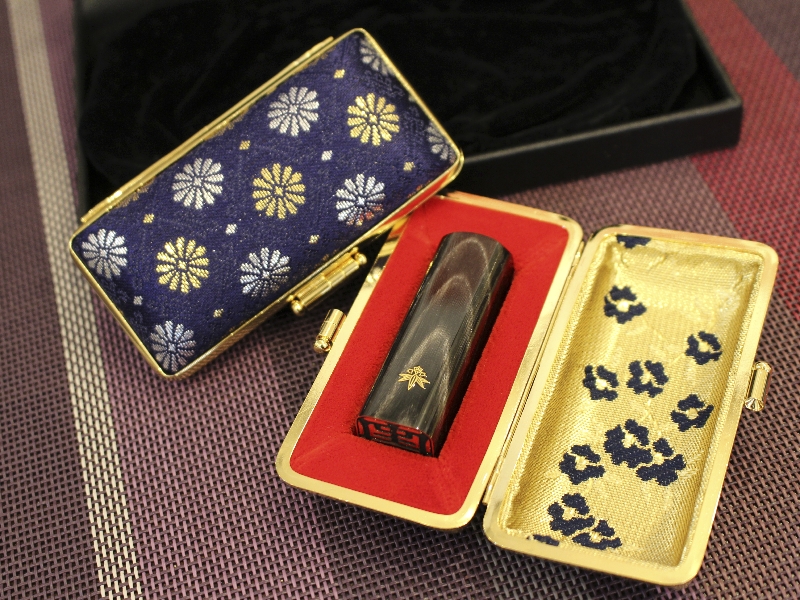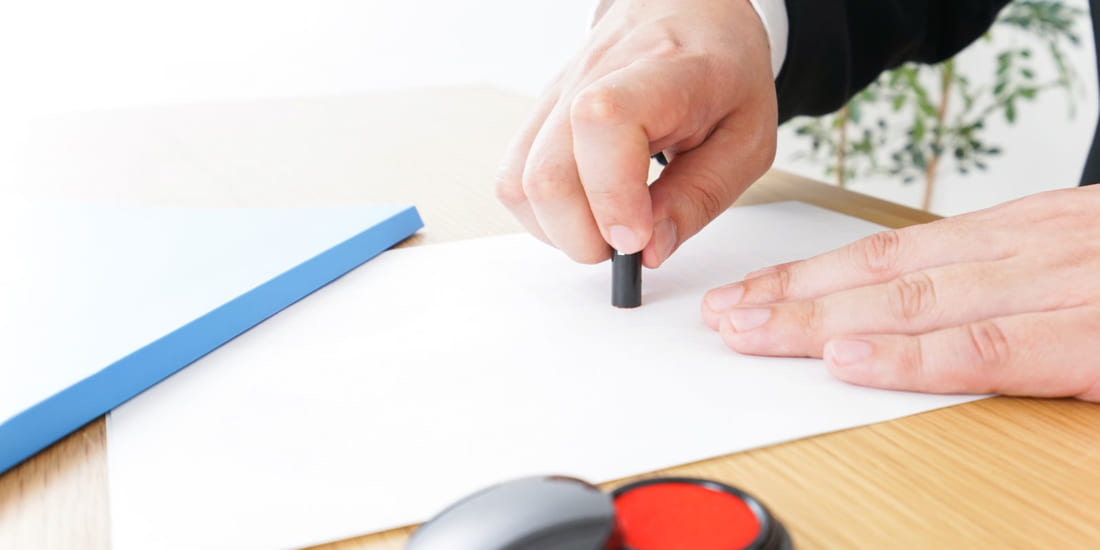Now that you’ve acquainted yourself with what a hanko is and what the basic types are, it’s time for an in-depth guide on its usage.
All Hanko Are Not Equal
The hanko is still an intrinsic part of the fabric of Japanese daily life. The jitsuin is an official registered seal there are strict specifications with regards to size, design and materials. Cheap rubber stamps are a no-no, as they deteriorate easily. The owner of this stamp is the only person allowed to use it — you cannot hand it over to your spouse or children to use in your place. The ginkoin, as its name implies, is a registered seal for bank dealings. Like the jitsuin, there are strict design and material specifications that muse be followed.
The mitomein is where you can get a little creative. You’re allowed to own as many as you like, but getting a high-quality hanko that lasts a long time means you can hand it down to your children or grandchildren. By creating a custom design hanko you add a personal touch to your seals, and it’s an excellent method of self-expression in a society where such outlets can be few and far between.
 Using Your Hanko — The Perfect Seal
Using Your Hanko — The Perfect Seal
If you already have a hanko, are you sure you know how to use it correctly? Everyone who has used a hanko will have some point encountered some or all the following issues: stamping your name upside down/at an angle, smudging the seal, getting an uneven print, or even double stamping. Despite its simplicity, using a hanko is an art and takes practice. Here are some quick tips to help ease the process:
1. Buying Your Hanko
Although you can find cheap hanko in almost every store, the quality and materials matter more than you think. High quality hanko reduce the risk of ink bleeding outside of the lines. They’re also made to last, meaning you don’t have to replace them every couple of years. By getting a personalized seal, you can choose the materials as well as the design, making sure it looks the way you want it and it lasts for as long as you need.
2. Holding Your Hanko
While it may sound like overly specific advice, holding your hanko correctly will decrease the chances of accidental blurring or stamping your name upside down.
Grip the hanko between your forefinger (at 12 o’clock) and your thumb (at 7 o’clock if you’re right-handed, 5 o’clock if you’re a leftie) and bend your middle finger to add support on the opposite side. Turn the hanko upside down and check the bottom of the stamp to make sure the top of your name is aligned with your forefinger. If not, adjust accordingly. Ideally, the top end of the hanko will press against the ball of your hand for additional balance. Use a strong grip and lower the hanko slowly to get an even, perpendicular imprint on the paper.
3. Tap that Red Ink
One of the easiest mistakes to make is to press the hanko into the red ink pad too hard. Doing this causes the ink to bleed between the lettering, creating an inky mess of your name. Instead, lightly tap your hanko into the ink pad 2-3 times. This will create a more even ink distribution. Many modern ink pads use fast drying ink which minimizes the risk of blotting too much but it never hurts to have a light touch.
4. Make Your Mark Using a Mat
A natsuin mat — a seal mat — is a cushioned mat used underneath the paper you’re stamping your seal on and is a worthwhile investment for business use. The mat helps even out the pressure to create a smooth imprint and is a necessity when stamping on uneven desk surfaces. It has the extra advantage of preventing slippage, too.
5. Make a の Shape When You Stamp
To ensure an evenly distributed stamp — without missing letters that will require you to repeat the action — imagine you’re writing the hiragana character の while pressing down. If you’re not too confident about your hiragana skills, adding pressure in a clockwise motion will provide a similar effect.
6. Clean the Hanko When You’re Done
It goes without saying that cleaning your hanko after use is a good idea. You’ll avoid getting ink everywhere and it will also make your hanko stay in better shape for longer. Simply wipe with a tissue or soft cloth before returning it to your hanko case.
Taking Care of Your Hanko
It’s important to treat your hanko with care. Consider registered hanko as important as your passport in terms of personal identification and store them safely, ideally under lock and key. Basic advice for hanko care:
- Keep your hanko in its case when not in use to prevent any external damage
- Keep it in a cool and dry place, out of direct sunlight
- After use, make sure to wipe any residual ink off
- Store your jitsuin hanko separately from the hanko registration card or any contracts you have used it with
- Store your ginkoin hanko in a different place from your bank book
If your hanko is stolen, report it to the police. Also, make sure to cancel it at your local ward or city office. If you’ve lost it, you must still cancel it. In this case, bring a new one along when you go to the ward office so you can register it as soon as you canceled the old one. You must then go to any bank you have used your registered inkan with to register it there, too. If you have signed any longstanding agreements — like a mortgage — you may need to redo the paperwork with the new hanko.
Signed and Sealed
The hanko’s role in Japan still holds utmost importance as contracts signed and stamped with a hanko provide the greatest levels of proof. For example, documents affirmed with both a handwritten signature in addition to a hanko stamp hold the highest credence in the court of law (followed by handwritten signature alone, digital signature plus hanko, and digital signature alone in terms of importance). As such, use your hanko wisely when applying your stamp to legal documents such as repayments, joint guarantor contracts, etc. Always check the content of a contract carefully and make sure you agree to all the terms before pressing your hanko stamp. The hanko makes for a great souvenir, but also plays an indelible role in Japan society.
Want to Get Your Own Hanko?
Kamakura Hanko stocks a variation of hanko — from simple to sumptuous — and accompanying accessories to suit any need. They can make a fully customized piece using traditional craftsmanship, or you can choose from many of the ready-made ones available. For a truly unique hanko, join a Kamakura Hanko workshop to make your own.
For more information, visit:
www.kamakuraseal.com/
www.kamakurahanko.com/
Stay tuned for our next post in the series, where we discuss how to create custom-designed hanko when you don’t have a Japanese name.
Sponsored Post
Updated On July 6, 2021


 Using Your Hanko — The Perfect Seal
Using Your Hanko — The Perfect Seal






